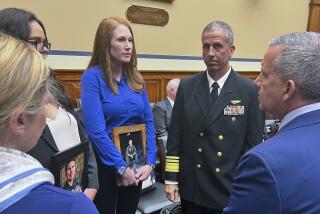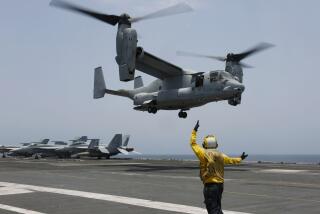Value of Grounded Osprey Aircraft Expected to Warrant Postwar Look
- Share via
MANAMA, Bahrain — With the U.S. campaign in Afghanistan winding down, the inevitable “after-action” analysis is underway in military circles to determine which weapons and strategies worked and which did not.
But the Marine Corps is also hoping the Afghanistan operation will help make a case for an aircraft that saw no action there: the controversial tilt-rotor V-22 Osprey, designed to land and take off like a helicopter but fly like a fixed-wing airplane.
The Osprey is meant to fly faster, farther, higher and with a heavier cargo load than older helicopters. Marine officials say those factors could be crucial in future missions like the one in Afghanistan, in which thousands of troops and tons of cargo were moved into hostile territory several hundred miles from support ships.
“The environment in which we’re operating in Afghanistan points out the advantage of an aircraft such as the tilt-rotor V-22,” said Maj. Rick Long, spokesman at Marine Corps headquarters in Quantico, Va. “You have a country that on its low end is almost a mile high and in the mountains rises to 18,000 to 19,000 feet. Those are hard altitudes for [existing] helicopters to operate in.”
The Osprey fleet was grounded a year ago after two crashes killed 23 Marines. The program later was snared in scandal when eight officers, including a two-star general, were accused in the falsification of maintenance records to keep the program from being canceled. Six were cleared, including the general.
The Marine Corps has stuck stubbornly with the V-22 program. Commandant Gen. James Jones and his wife took a highly publicized flight in an Osprey last year to attest to its safety.
On Dec. 21, the Defense Department announced it will resume test flights in April to see if the design problems that may have contributed to the two deadly crashes have been fixed.
Marine Corps officials say that the Osprey is needed to replace the aging fleet of CH-46 Sea Knight and CH-53 Sea Stallion helicopters. Workhorse designs from the Vietnam era, many of the helicopters have undergone extensive upgrades, an expensive process to extend their usefulness.
The Sea Knights and Sea Stallions were successfully used to resupply Marine outposts at Camp Rhino and the bombed-out Kandahar airport in southern Afghanistan. But they required a complex system of refueling and were forced to fly through valleys where Taliban and Al Qaeda soldiers were known to be equipped with shoulder-launched Stinger missiles. The Osprey could have flown higher and without refueling, the Marines say.
Before the Ospreys were grounded in December of last year, the Marine Corps had taken delivery of 20. The initial goal had been for the Corps to buy 360, the Air Force 50 and the Navy 48 under a $40-billion acquisition program.
Critics of the Osprey program cite safety as their main concern, but any expensive military acquisition also needs political support. When he was defense secretary in the first Bush administration, for example, Vice President Dick Cheney opposed the Osprey because of cost and technology concerns.
As the Osprey program again becomes a topic of discussion in Washington, references to Afghanistan are expected to be common.
“That bird was made for the Rhino mission--deep, over-the-horizon kind of stuff,” said one Marine officer in Afghanistan.
More to Read
Sign up for Essential California
The most important California stories and recommendations in your inbox every morning.
You may occasionally receive promotional content from the Los Angeles Times.










